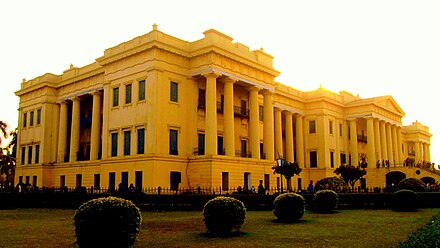Murshidabad and Nadia
Murshidabad and Nadia

 The Murshidabad and Nadia districts of West Bengal play a crucial role in the history of Bengal.
The Murshidabad and Nadia districts of West Bengal play a crucial role in the history of Bengal.
Murshidabad (Bengali: মুর্শিদাবাদ MOOR-shih-dah-bahd) was the capital of Bengal during the Nawab rule, which has become one of the major tourist centres in West Bengal.
Nadia (Bengali: নদিয়া NOH-dih-yah) was once known as the "Oxford of Bengal" and has made many contributions to Indian philosophy, such as the Navya-Nyaya system of logic and is the birthplace of the Vaishnava saint Chaitanya Mahaprabhu.
Cities
Murshidabad
-
Baharampur — headquarters of Murshidabad district, fortified British cantonment with Dutch, French, Mughal and Portuguese architecture and reminiscences
-
Jangipur, Dhuliyan and Farakka — three towns in northern Murshidabad district
-
Murshidabad — former capital of Bengal under the Nawabs
Nadia
-
Krishnanagar — headquarters of Nadia district
-
Kalyani — a planned township
-
Mayapur — religious centre, home to ISKCON Temple
-
Nabadwip — temple city and heritage town
-
Palashi (Plassey) — famous for the historical Battle of Plassey between Nawab Siraj-ud Daula and British East India Company
-
Santipur —
Other destinations
- Bethuadahari Wildlife Sanctuary 📍 — wildlife centre
Get in
Get around
See and do
The major attractions in the region include the Hazar Duari Palace in Murshidabad, the historic site of Palashi and Sri Maya Chandrodaya Mandir in Mayapur. Besides these attractions, you can take a boat ride across the Bhagirathi River. There are numerous ferry terminals on both banks of the river, where you can rejoice in the beauty of the river.
Eay and drink
The ground water is normally unsafe for drinking, as it might be contaminated with arsenic, fluoride, or both. So you are better off drinking from the municipal or panchayat (village administration) supply of surface water or bottled drinking water of reputed companies, not of ordinary companies, here and there in Central Bengal, even if those are cheaper by ₹2 per litre.